Support Us
Since 1979 more than 140,000 animals have been treated by Wildlife Rescue.
Thanks to the support of individuals like you, Wildlife Rescue can provide a lifeline for animals in distress.
After a successful summer, we are happy to announce that Wildlife Rescue’s Summer Admissions Centre has now closed. Admissions has returned to our Main Site at 5216 Glencarin Drive.
We would like to thank our community members for their unwavering support during this disruption to our regular service. We were pleased to connect with more people than ever at our temporary location, with nearly 1,000 patients admitted through the centre during operations.
We would like to thank FortisBC and Kiewit Corporation for their partnership during the Patullo Gas Line replacement project. Thanks to their help, our Temporary Admissions Centre was made possible.
If you have found an animal in distress, we are happy to assist you at our Main Site at 5216 Glencarin Drive. Please call our Wildlife Rescue Support Centre at (604) 526-7275 for guidance and support before traveling with the animal.
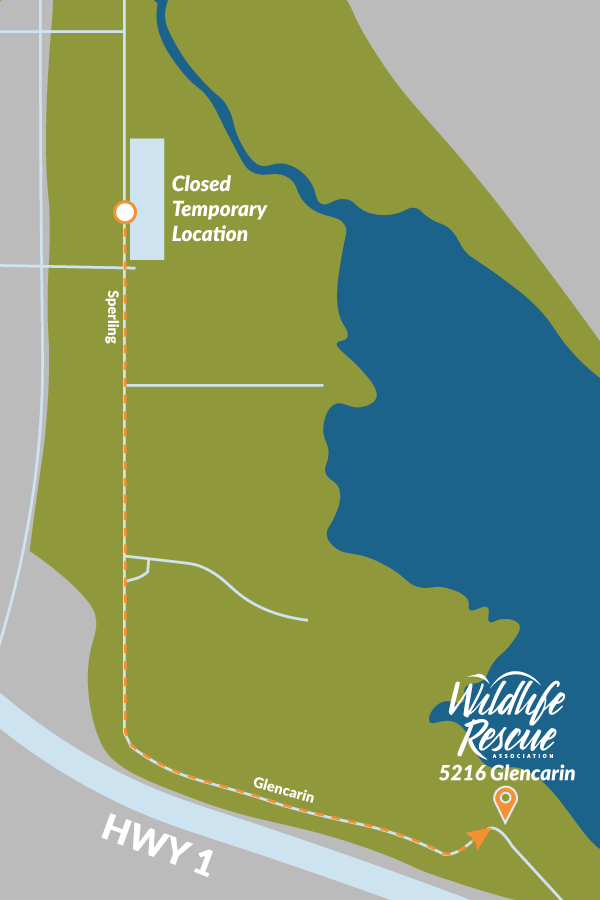
After a successful summer, we are happy to announce that on October 19th Wildlife Rescue’s Admissions Centre will be returning to our regular location at 5216 Glencarin Drive. The Summer Admissions Centre will be permanently closed as of this date.
Since opening the Summer Admissions Centre, Wildlife Rescue has admitted over 1,000 patients! We are pleased to welcome you back to our permanent address after almost half a year of construction on Glencarin Drive. Our work is only made possible with your support, and we were happy to connect with so many people over the summer at this temporary location.
We would like to thank FortisBC and Kiewit Corporation for their partnership during the Patullo Gas Line replacement project. Thanks to their help, our temporary Admissions Centre was made possible.
If you have found an animal in distress, please call our Wildlife Rescue Support Centre at (604) 526-7275 for guidance and support before travelling with the animal.
Thanks to the support of our incredible community, and the integral partnership of FortisBC and Kiewit Corporation, Wildlife Rescue’s Admissions Centre is officially OPEN.
We look forward to welcoming you to our new location, whether you have found an injured or orphaned animal in need of care, or you are visiting to provide essential support through donations or in-kind gifts. Our work is only made possible with your support and we know this new location will give us the opportunity to connect with you better than ever!
With our animal intakes increasing every day, your continued support is needed now more than ever. Thank you for all you do!
Wildlife Rescue’s Admissions Centre is located in front of the Burnaby Lake Rugby Club at 3760 Sperling Ave, Burnaby, BC V5B 4X5. Follow the Wildlife Rescue signs!

If you have found an animal in distress, please call our Wildlife Rescue Support Centre at (604) 526-7275 before you arrive for guidance and support.
Wildlife Rescue’s new Admissions Centre will be operating from this location through the rest of the summer and joining the Wildlife Rescue Hospital at 5216 Glencarin Drive this fall.
To our valued Wildlife Rescue supporters,
As you may already know, cases of HPAI (Highly Pathogenic Avian Influenza) have been detected in BC. We want to let you know that Wildlife Rescue Association is aware of this risk and has taken action to keep staff, volunteers, and our feathered patients safe. We are continuing to monitor this situation, following the guidance of the Public Health Agency of Canada, and will adapt as needed to ensure the highest level of safety is assured.
For the most current guidance regarding wild birds, bird feeders, caring for domestic birds, and reporting sick or dead birds—please visit the official Government of Canada website at the link below.
Wildlife Rescue Association is not responsible for the surveillance of Avian Influenza in Canada. For the most up-to-date reports and information on the status of HPAI in Canada, please refer to the Government of Canada website at the link below.
Thank you for your continued support of our wildlife patients at this time!
Current research suggests that well-maintained bird feeders and hummingbird feeders are low-risk, but not no-risk, for transmitting many diseases including this virus. If you choose to keep a bird feeder or hummingbird feeder, please remember that this is an important responsibility. Clean and maintain your bird feeders regularly to ensure the safety and wellbeing of wildlife now, and year-round.
Backyard bird feeders, hummingbird feeders, and baths should be cleaned regularly using a weak solution of domestic bleach (10% sodium hypochlorite). Ensure they are well rinsed and completely dried before re-use. If you are not able to diligently maintain and clean your bird feeder, please consider removing it for the safety of your wildlife visitors.
Please note, this situation is evolving and this guidance may change. Always refer to the official Government of Canada website for the most current official guidance.
Additional information regarding bird feeders and bird baths is being provided by the BC SPCA.
Their advice is an extra step you can take to support wildlife in BC. For more information about this step, please refer to the BC SPCA website at the link below.
For the most current information and official guidance regarding this evolving situation, please always refer to the Government of Canada’s Avian Influenza Surveillance
Volunteers are an integral part of Wildlife Rescue and they are involved in every aspect of the work that we do. We deeply appreciate each and every person that generously gives their time to help give our wildlife patients a second chance at life. Join us this week as we take a sneak peek into an average day for volunteers at Wildlife Rescue!
Written by Waterfowl Rescue Volunteer, Cathy
As a waterfowl rescue volunteer, I’ll get a text message from the Wildlife Rescue Support Centre with the location, contact info, and a brief description of the situation. I will respond with an estimated ETA, and then contact the finder (the community member who found the animal), just to confirm the address and any other details. After a quick check of my vehicle, to make sure I have all the equipment needed (kennels, towels, blankets, nets, gloves, food for luring)-I’m off!

Rooftop rescues are usually done with a team of two or three, but there are cases when there just isn’t another team member available.
In this case there was a Canada goose family nesting on a balcony of a 4th floor condo at the east end of False Creek. The mom and goslings were on the patio, but the dad was on an upper ledge. For safety, and the least stress possible on the animals, I decided to catch the mom, get her in a kennel, then get the babies into the smaller kennel. The dad flew down to the ground, and by the time I got down with the mom and babies, he was waiting there, honking for his mate. As I carried the mom and goslings, he followed us across the street to the water’s edge where the family was released, all together again.
As soon as one rescue and release is complete, there is usually another to go to!
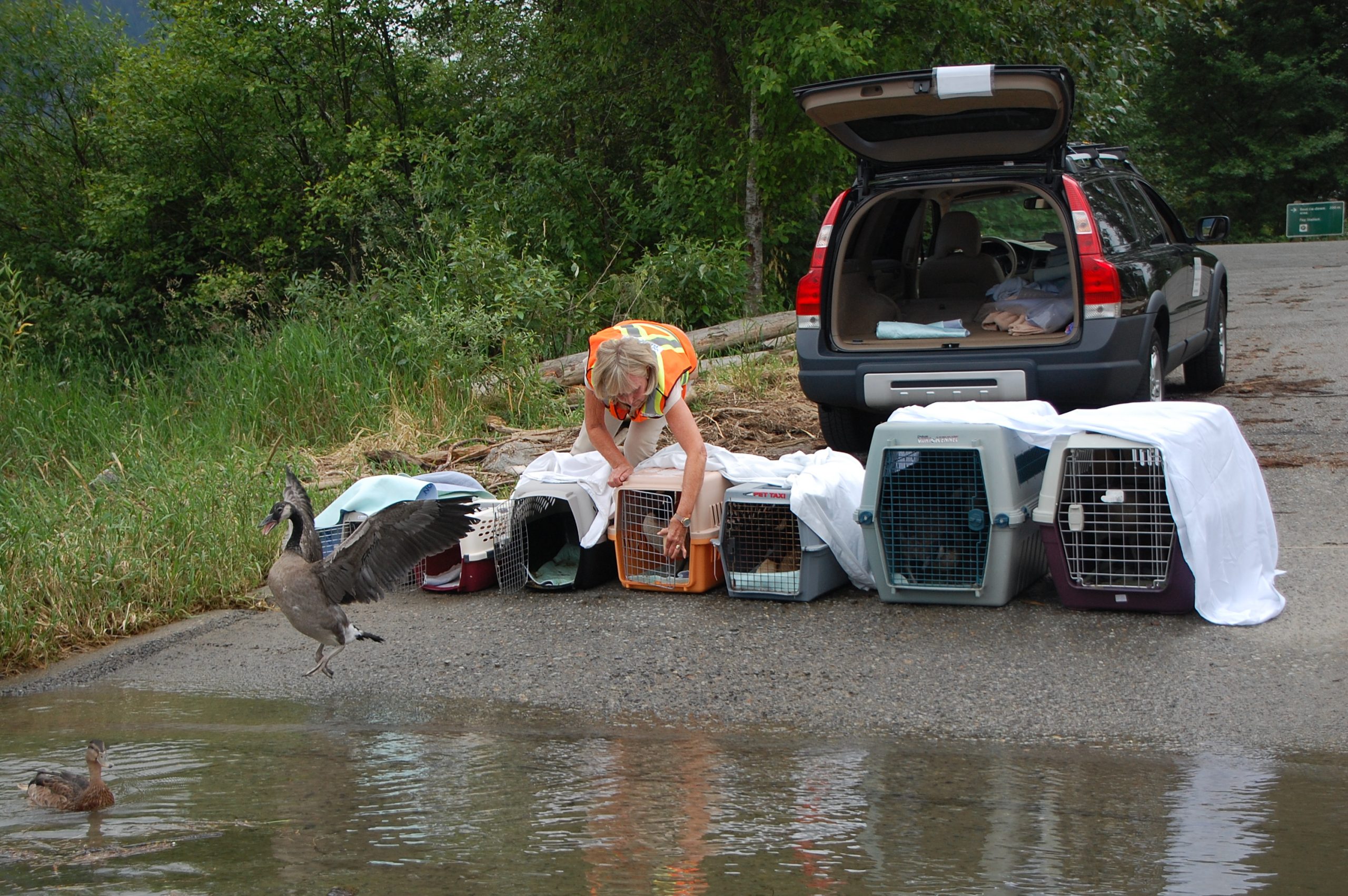
My next stop was to rescue a group of Mallard ducklings trapped on a ledge. The mom and some of the ducklings had made it to the ground and headed for the nearby pond. I quickly climbed up to access the ledge, scooped up the remaining babies, and took them to the pond to reunite with their family.
After that, I headed over to a downtown rooftop where a young Gull tangled up in garden netting. The parents were not happy with us being up there. We used an umbrella for protection from the dive-bombing parents and finally got the young gull free. We carefully removed all of the netting to prevent future entanglements.
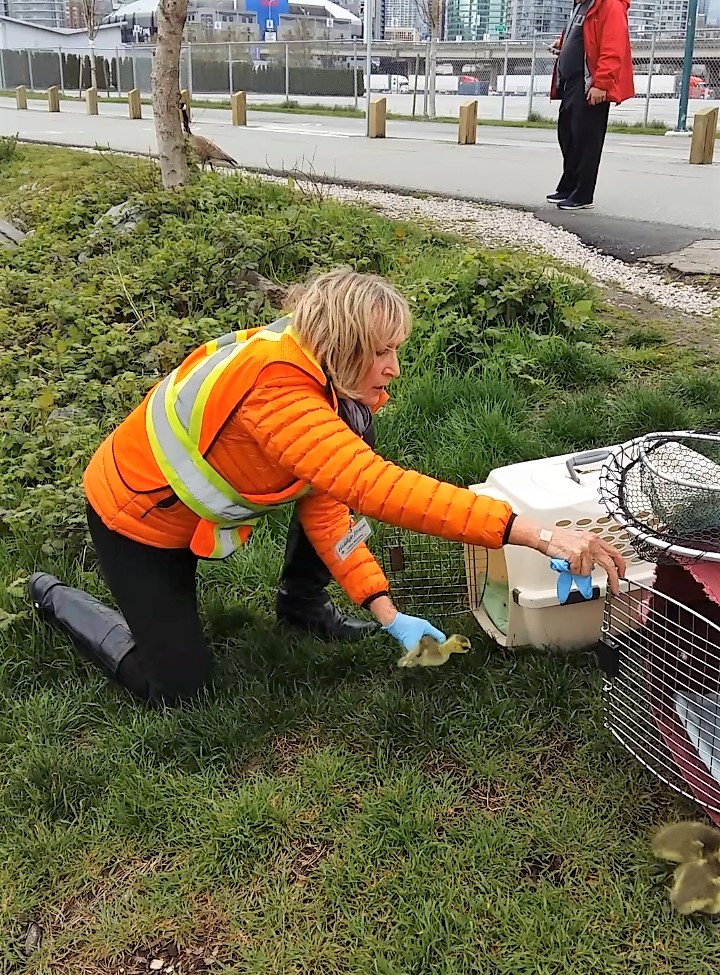
My last rescue of the day was another Mallard family rescue, this time trapped in an inner courtyard with no way to get out. Female mallards are notoriously flighty, so it can be challenging to capture her without her taking off and abandoning her babies. We use a domed tent-like structure to herd her into so we can net her, then scooped up the ducklings. With the entire family rescued, we were off to the nearest suitable water source, where they were successfully released.
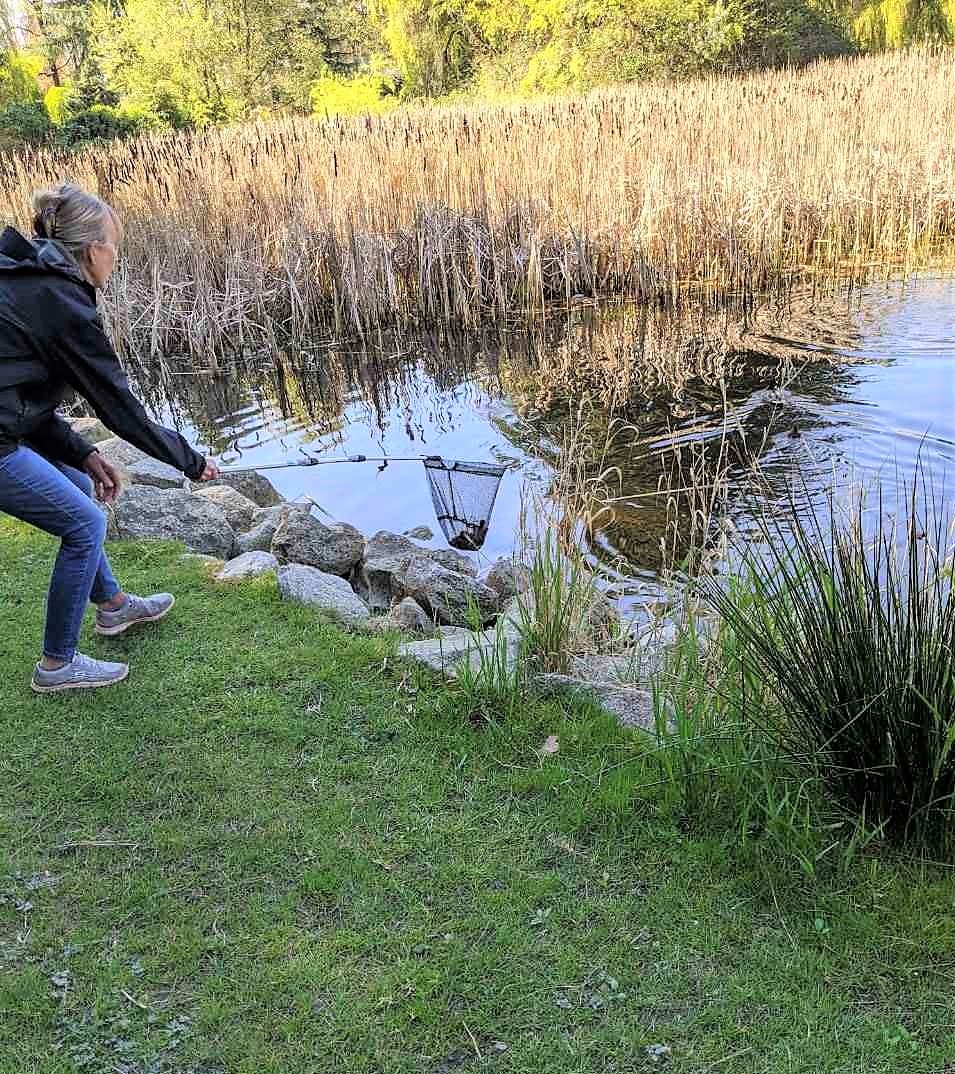
Throughout the busy Waterfowl Rescue season there are lots of calls about waterfowl in need of rescue. But, there are also always calls about orphaned skunks, raccoons, beavers, opossums and more! I try to fit these calls in between the roof top rescues and help as many animals as possible
At the end of the day, I clean out the kennels, replenish supplies, and get ready for another day of rescues!
Join the team! Learn more about volunteer opportunities and how to apply >
Volunteers are an integral part of Wildlife Rescue and they are involved in every aspect of the work that we do. We deeply appreciate each and every person that generously gives their time to help give our wildlife patients a second chance at life. Join us this week as we take a sneak peek into an average day for volunteers at Wildlife Rescue!
Written by Helpline Volunteer, Nancy
As a Support Centre volunteer, we help out with admitting new animals and answering calls that come in to our Wildlife Rescue helpline. It is my first spring volunteering with Wildlife Rescue and we’re heading into the busiest time of the year, so the Support Centre Coordinator is close by to help me out if I have any questions. This day, we received lots of calls about baby birds and nests! This is a Day in the Life of a Support Centre volunteer!
12:20 – Arrived at WRA and greeted my fellow volunteer, Clare, who was admitting a new patient at our animal intake shed.

Clare at the intake shed
12:30 – Signed in and got an update from another volunteer, Brenda, who was finishing her helpline shift. She filled me in about a call she was expecting to come in a bit later from a community member so I could best support them. 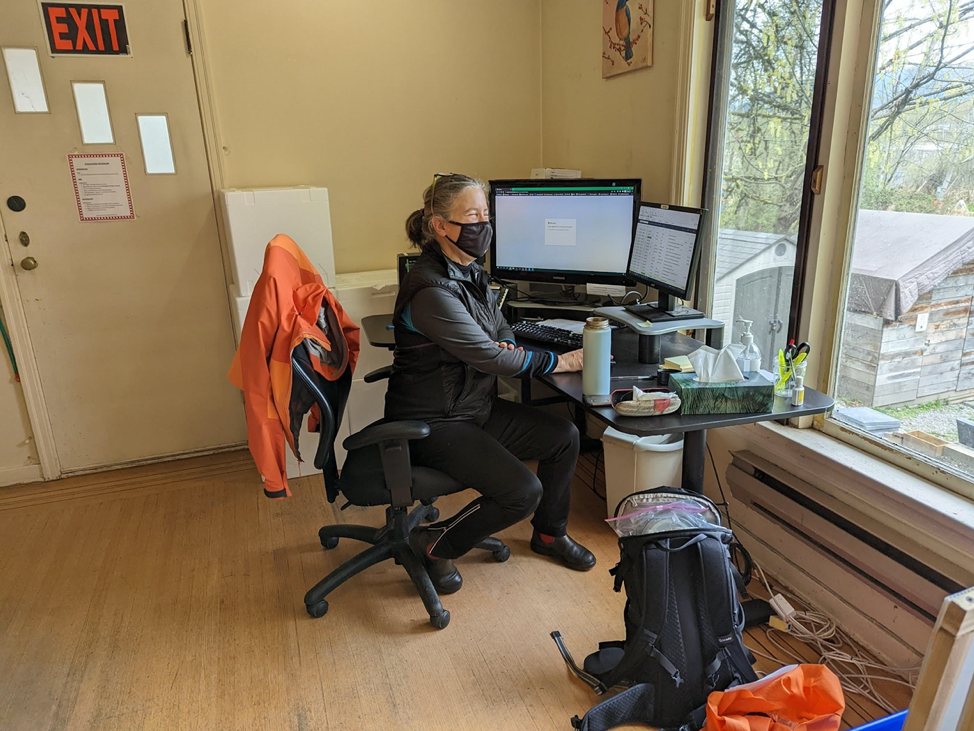
Brenda at her desk
12:45 – Wildlife Rescue received a about goose nests on a rooftop. I recorded information to schedule arescue of these newborns once the eggs hatch.
Did you know: Canada Geese always return to the same place they were born to nest, even if a building or other development has popped up right on the spot! This keeps Wildlife Rescue busy year after year, safely rescuing and guiding newborns and their mums back to a safe, natural environment.
12:55 – I recorded all of the information from any voicemails that came through during other calls and responded accordingly.
13:10 – Wildlife Rescue received a call about an injured goose. I recorded the details and location for the Support Centre staff to arrange a rescue right away.
13:25 – An email came through about an injured Mallard with a video for assessment to determine the injury and if a rescue was needed.
13:30 – A call came through about an injured animal to be dropped off by a member of the community. I let Wildlife Rescue admissions staff know to expect them soon!
13:45 – I met an officer dropping off a Rock Pigeon from New West Animal Shelter to receive care at Wildlife Rescue.
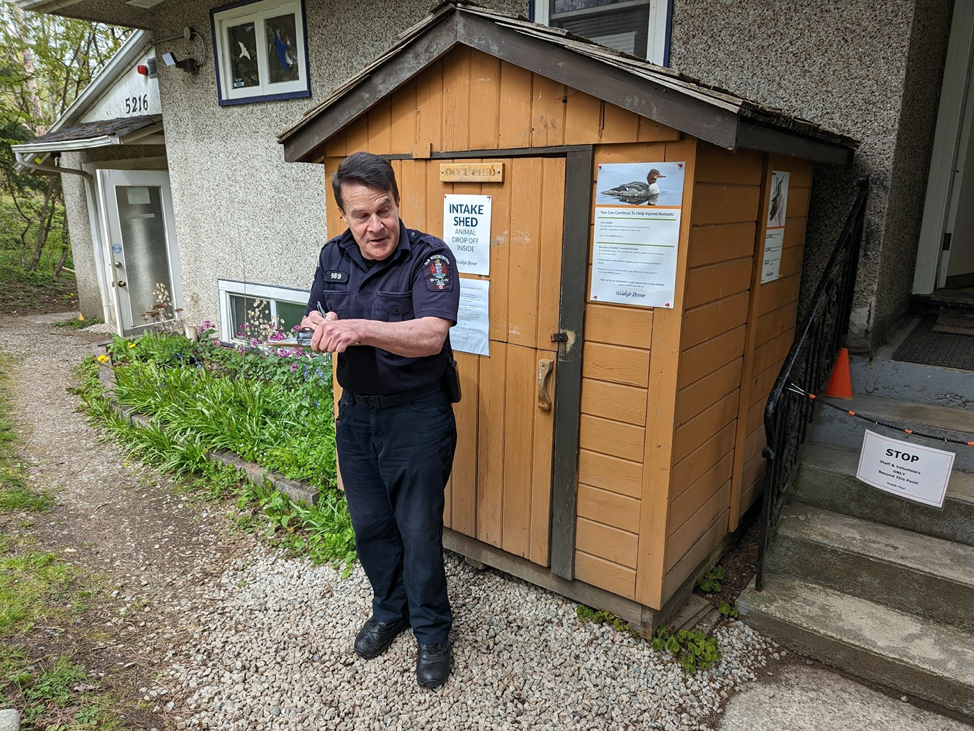
Officer Phil filling in a form with information about the Rock Pigeon he dropped off
14:00 – We received a call about geese behaviour and provided information to the caller to help them out.
14:10 – An available volunteer called and we arranged for them to assess the injured Mallard from earlier in person.
14:20 – We received a call about another rooftop goose nest rescue!
15:00 – We received a call from a concerned community member asking for advice on what to do with trapped ducklings with no mother around
Did you know: Ducklings rely on their mothers to survive—but if she becomes stressed, she might abandon her ducklings! If you see ducklings with no mother nearby, call the Wildlife Rescue Support Centre at (604) 526-7275 right away. Learn more about Mallard Duckling Season in our FAQ here.
15:10 – We received a call about birds nesting in an unsafe location, and provided guidance about nesting deterrents.
Did you know: if you see birds nesting in an unsafe place year after year, there are ways to safely try and divert them. Check out this article on goose nesting for more information.
15:30 – We received a call about an injured seagull who needed to be rescued and treated
15:40 – I sent out a request to Wildlife Rescue’s transport volunteers to arrange for the injured seagull to be picked up and brought right in for care!
16:00 – We received an update from our volunteers about the ducklings from earlier – the Mallard mother and ducklings were successfully reunited! What an amazing way to end the day!
16:10 – Signed out and our Support Centre team shared new photos of ducklings in our care swimming in a newly fixed up enclosure and reminds me why I’m so proud to be a part of the team helping these little ones at Wildlife Rescue!
Join the team! Learn more about volunteer opportunities and how to apply >
Volunteers are an integral part of Wildlife Rescue and they are involved in every aspect of the work that we do. We deeply appreciate each and every person that generously gives their time to help give our wildlife patients a second chance at life. Join us this week as we take a sneak peek into an average day for volunteers at Wildlife Rescue!
Written by Garden Volunteer, Teresa
I joined the Wildlife Rescue Association (WRA) back in March 2021 when I saw a volunteer opportunity I couldn’t resist: to assist in implementing the Wildlife and Demonstration Garden Plan at WRA.
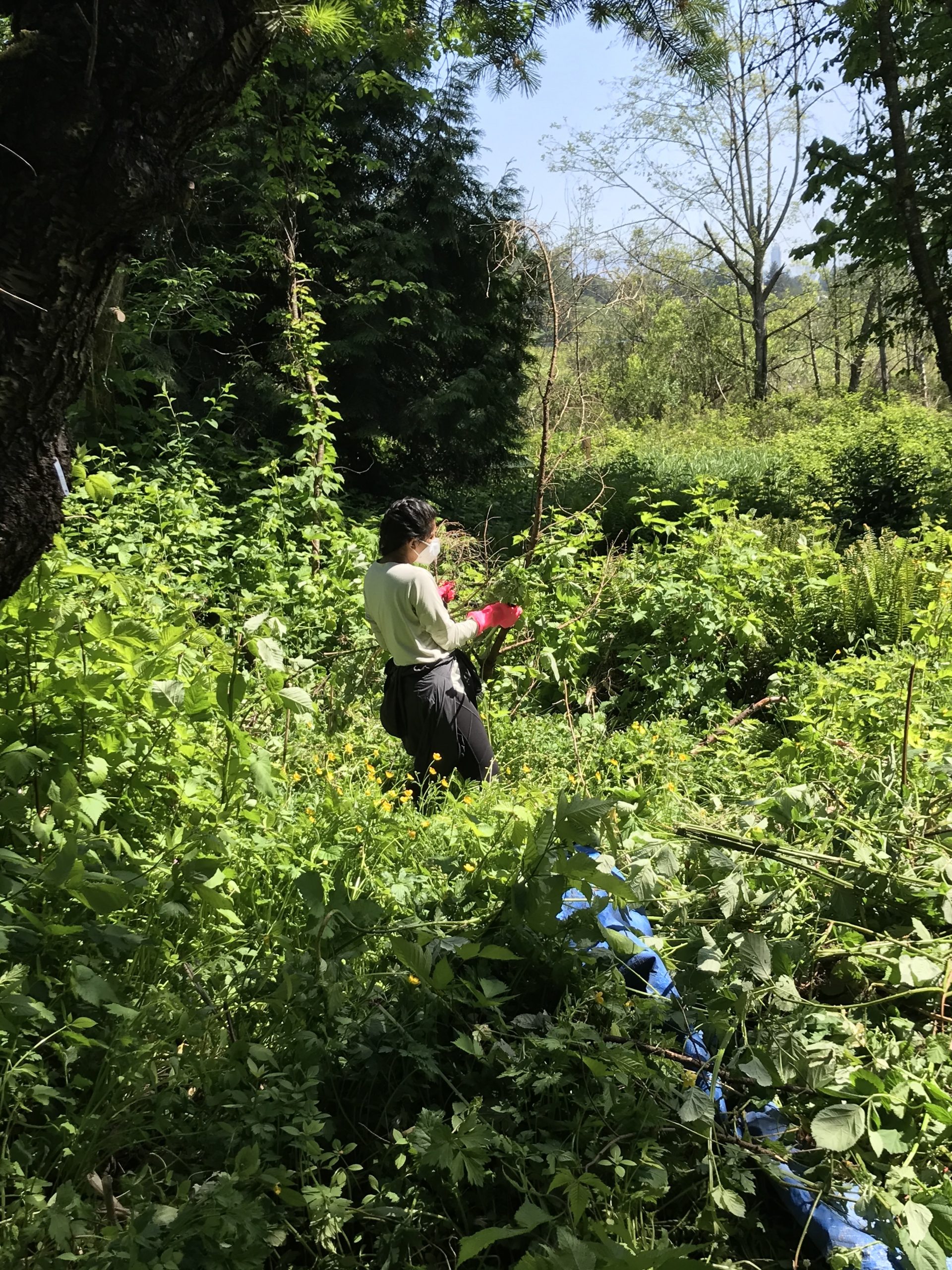
During my years as a landscape designer in Vancouver, I have found myself drawn more and more towards natural, ecologically sound landscape designs. The chance to assist in the creation of a wildlife garden, on such a beautiful site, was a dream.
The wildlife garden will provide shelter and food to birds, insects, and much-needed pollinators. It will also serve as a demonstration garden for visitors and a beautiful workspace for WRA volunteers and staff.
Right now, the focus of my work is to get rid of invasive species on-site and prepare the soil for the planting of native trees, shrubs, and perennials. A typical garden shift at WRA starts with a round of the site, to identify patches of Himalayan blackberries and morning glory to be uprooted, as well as maintenance tasks to complete.
Once the maintenance chores are done (mowing, weeding around enclosures, pruning), the serious job of weeding out of invasive species begins. This is physically demanding work, but at the end of the day, it is wonderfully satisfying to see the site free of weeds and ready to be planted.
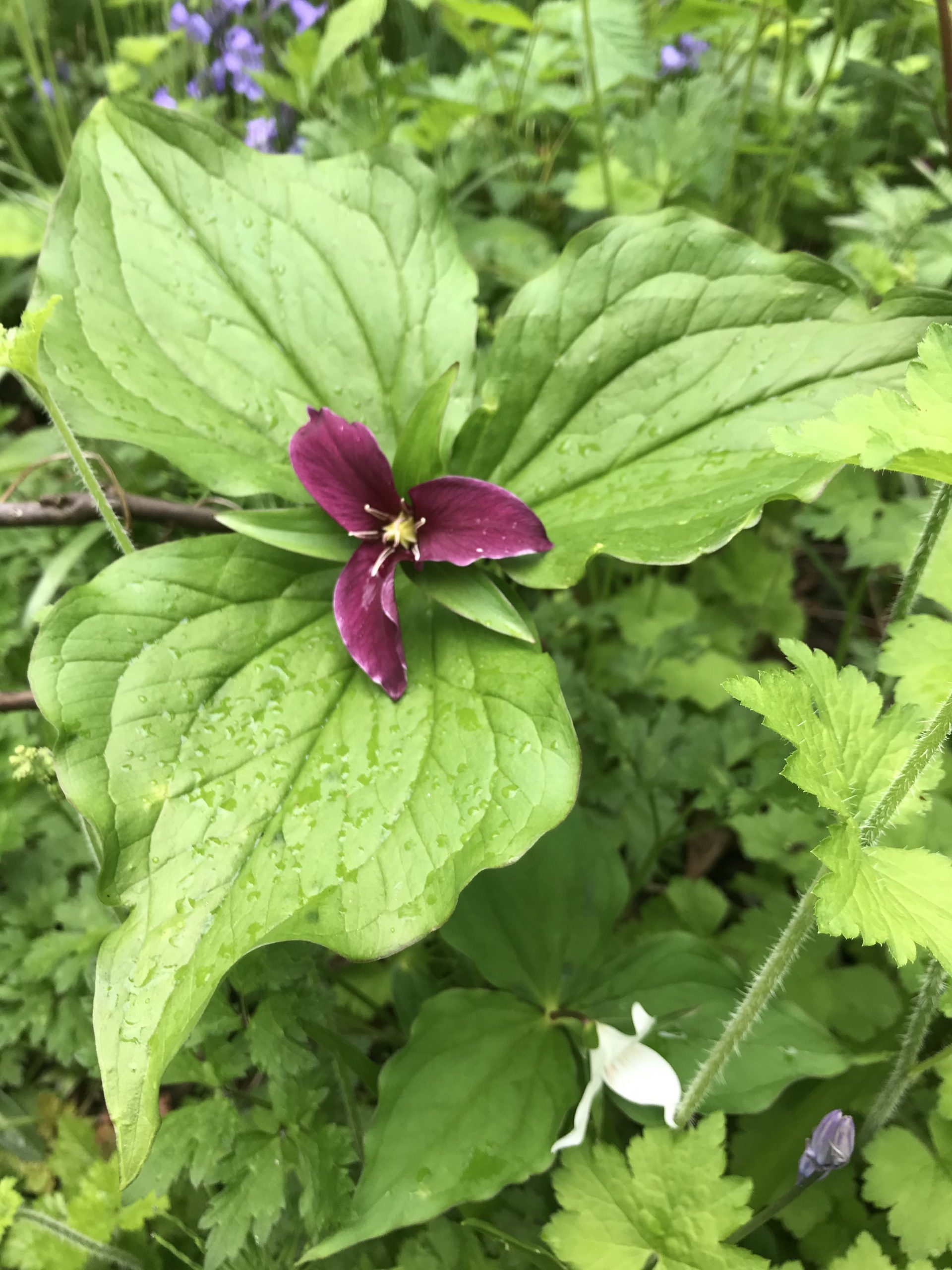
On my breaks, I sit by the lake watching the birds and ducks and feel lucky to be part of this wonderful project for positive change: providing much-needed shelter and food for local and migratory wildlife.
WRA’s site is full of surprises and delights – I have found hummingbird nests, delicate trilliums hiding amongst the weeds, and seen geese waddling by.
Garden work parties, where a larger group of volunteers and staff from across the organization come together to put in a few extra dedicated hours, are another highlight! I meet generous volunteers from all over the world, keen to help, hard-working, and ready to share their own unique knowledge of nature and wildlife.
Join the team! Learn more about volunteer opportunities and how to apply >
Volunteers are an integral part of Wildlife Rescue and they are involved in every aspect of the work that we do. We deeply appreciate each and every person that generously gives their time to help give our wildlife patients a second chance at life. Join us this week as we take a sneak peek into an average day for volunteers at Wildlife Rescue!
Written by Animal Care Volunteer, Isabel
2:50 pm – Arrived for my shift at the Wildlife Rescue hospital and was surprised with the best brownies and cupcakes in the break room—could the day start any better?
3:00 pm – I introduced myself to the new animal care volunteer I would be mentoring for the day, checked the board to see when the next patient feeding was coming up, and picked up a radio to keep in touch with the rest of the Wildlife Rescue team.
When one shift begins, another is just finishing up! Our first task of the day was to check in with the earlier shift and we helped them out with setting up greenery in a patient enclosure before they left for the day.
3:10 pm – We set up Aviary 14- a big enclosure with lots of greenery, milk crates, and roses nestled in the branches to give our feathered friends lots of fun places to perch and safe places to hide. Five volunteers on shift worked together and the job was done quickly! Wildlife enrichment is one of my favourite parts of volunteering at Wildlife Rescue because you get to be creative and wildlife live and play in your art! We create places to hide and perches at different heights to help them build their natural skills, keep their muscles strong, and be successful in the wild. It’s so special to give them a fun and safe environment that supports their needs whether they’re recovering from an injury or just learning how to fly!

3:30 pm – My mentee and I did some training and practice on common animal care shift tasks such as washing crates, preparing safe veterinary disinfectant solutions, and arranging clean and dirty laundry. We took a tour around Wildlife Rescue’s site to learn where the animal care tools and resources can be found and learned about animal safety and handling protocols.
One of the most important things we learn as animal care volunteers at Wildlife rescue is the important health indicators to look for in our wildlife patients and when to communicate concerns to staff. As we’re so often close by to feed patients or visiting their enclosure to clean up, volunteer observations can be key to their successful care!
4:30 pm – We visited the kitchen to check which patients needed to be fed at this time. By referencing the feeding schedule, our patient codes, and each patient’s respective diet in the manual, we were able to determine exactly which foods to pick up.
The schedule let us know we needed to check on some of the ducklings so next we visited 12baby ducklings in the brood sheds to see what food needed to be topped up and what needed cleaning. I demonstrated how to safely move the ducklings into a carrier while cleaning their enclosure and how to safely place them back while minimizing human contact and stress as much as possible. I cleaned both enclosures, carefully demonstrating the extra safety precautions we take at Wildlife Rescue such as diligently replacing gloves between each cleaning.

5 pm – We brought some dirty dishes to the sink, and garbage to the bin. Once we were washed up again, I supervised my mentee as we put together patient diets for more feedings. We carefully went through each enclosure and followed the protocol to open them safely and replace dishes with fresh food. Our new volunteer did a wonderful job and all patients were fed in no time! .
6 pm – We went back to the kitchen to complete some maintenance on our food preparation tools such as washing all the dishes from the day and sharpening knives.

7 pm – It was time for the last feed of the day and we fed the youngest of the ducklings we have in our care. Once again following Wildlife Rescue’s careful protocols, we removed the ducklings, cleaned their enclosure, and fed them their evening meals with as little stress as possible.
Afterwards, we visited the older ducklings as well and learned the differences in diet for each duckling stage and how to read the diet sheet to provide the right nutrition.
7:30 pm – We divided forces to wash the last dishes, sweep, and mop. We took out the garbage, recycling, and laundry and I filled out my mentoring report for this shift.

Finished for the day, we said goodbye to Wildlife Rescue and headed home!
Join the team! Learn more about volunteer opportunities and how to apply >
Unlike songbirds, baby ducks and geese leave the nest almost immediately after birth, and will follow their mom closely. They already know how to find their own food, but still need their families for warmth and protection. Baby ducks and geese can go in water briefly, but because their feathers are not yet waterproof, they can quickly become hypothermic (chilled) if they remain in the water more than a few minutes. If you find a baby duck or goose alone, it is almost certainly just separated from its family.
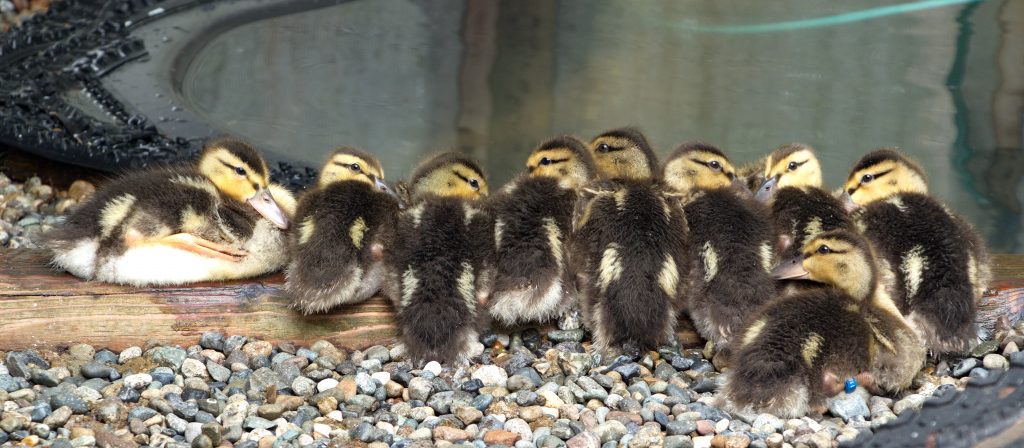
If you find a Mallard nest with only a few eggs in it, allow the mother to finish laying all of her eggs (typically 12-13 total). Mallards lay one egg a day, so this will take up to 12-13 days. She will not start incubating her eggs (laying on them) until all eggs are laid, so finding a nest with only three or four eggs and no mother duck does not mean that the nest is abandoned.
If something does happen to the unfinished clutch of eggs, Mallard hens will make another attempt until they raise a successful brood.
Once all eggs are laid, she will rarely leave the nest apart from short breaks to feed and stretch her legs. About 28 days later the eggs hatch together. This takes about 24 hours.
Mallard eggs are unmarked creamy to grayish or greenish buff. There are typically 12-13 eggs per clutch.
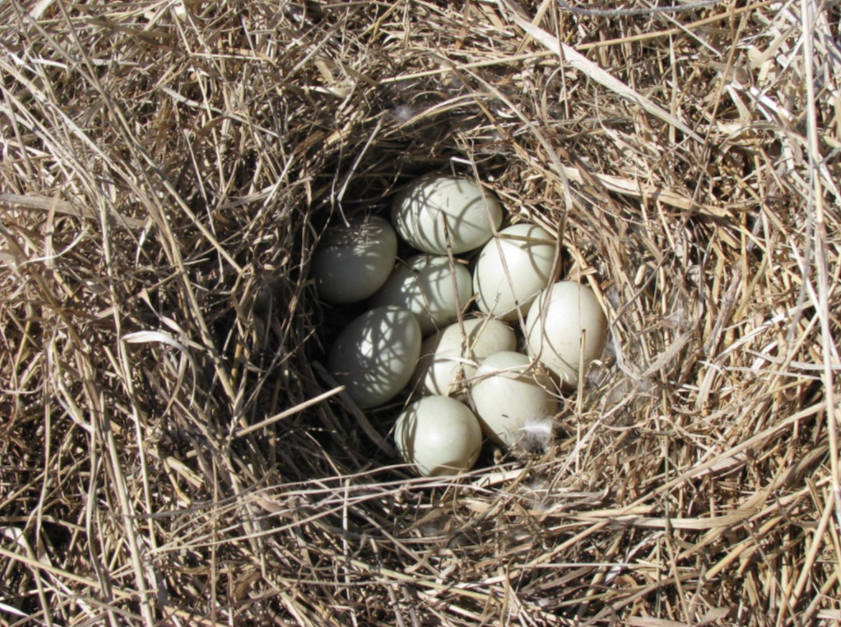
Photo Credit: USFWS: https://www.flickr.com/photos/usfwsmtnprairie/11856952175
Once hatched, the ducklings will stay in the nest for at least 10 hours while they dry and get used to using their legs. Then, usually in the early morning, the female leads them to water. Bad weather may delay this, but the sooner the ducklings get to water to feed, the better their chances of survival. They cannot survive without their mother, and take 50-60 days before they fledge and become independent.
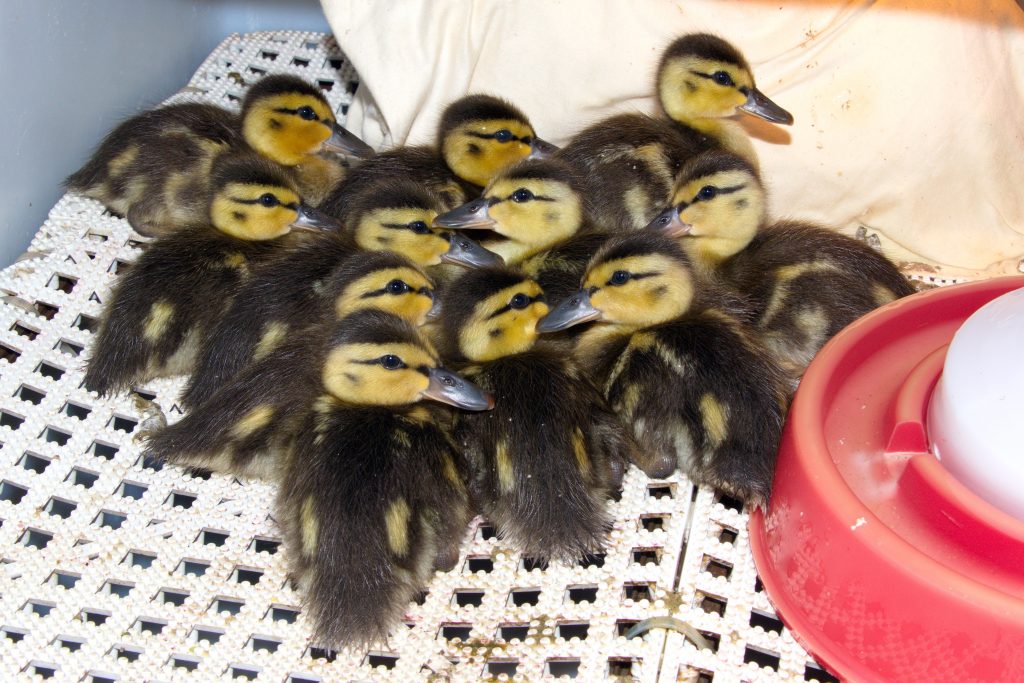
The mother duck may have been spooked away and has not returned. Keep the babies protected and wait from a nearby location to see if the mother returns. She will usually return within a half-hour if the area has become quiet again and the threat is gone. She is very protective of her babies and will not go far or stay away for very long. If the mother does not return to her babies within 1-hour, the ducklings should be rescued and brought to Wildlife Rescue.
Hypothermia will result if babies are in a pool for more than a few minutes. Mother will stay in the pool with them (to protect them) if they cannot get out and it appears as if she is voluntarily allowing them to swim. She will exit the pool as soon as the babies are given a means to get out of the water. Be sure to screen skimmer or filter openings that may trap helpless ducklings with suction.
Pool covers are an effective control for uninvited pool guests. They are also safer for other wildlife (baby birds) that may fall into it. Other measure to discourage ducks from pools include; floating alligators or beach balls (they must be moving continuously); sensor sprinklers or sprayers strategically placed; monofilament barriers (installed by professionals); music, radio or strobe lights activated by sensors. Some professional companies specialize in exclusion devices for wildlife.
Mallard ducks are federally protected, so moving the nest is illegal without a permit. It is unlawful for any person to capture, possess or relocate ducks (and other migratory birds) except by permit. We encourage you to let the ducks finish nesting. After the ducklings hatch and the family moves on, you can put up deterrents to prevent them from nesting there again.
Ducklings/ goslings can safely jump to the ground from buildings that are less than 2 stories high and if there is no barrier/edge higher than 12cm. If a family of ducks have nested on a building that is taller than 2 stories and/or there is a barrier higher than 12 cm it is best to contact Wildlife Rescue’s helpline, (604) 526-7275. Wildlife Rescue has trained volunteers that can help with these rescues. Mother Mallards may not return to their ducklings if stressed so it is important to contact Wildlife Rescue first before attempting capture.
It’s normal for a female mallard not to eat for the entire incubation period – she fattens up beforehand to prepare. Leaving food or water out for the duck will only attract predators like raccoons or opossums, putting the nest in danger. Once the ducklings have hatched, feeding them unnatural food like bread can cause problems with their growing bones and feathers.
Always consider human safety first– never put yourself or other people in danger to help a family of ducks cross a road. You can help by waving at drivers to alert them to the birds. Ask passersby with pets or children to keep back. Keep a safe distance, and try to gently steer the birds in the direction of the closest pond, stream, river, or lake.
It may seem like a good idea in these situations to try to catch the family and move them to a safe spot, but this risks scaring off the mother and scattering the babies.
Remember that crossing roads is a fact of life for urban wild animals, and one of many skills babies need to learn from their parents.
Some rescues are best left to the experts, and duck families on multi-lane highways with barriers and heavy traffic may need help. Please contact the non-emergency police line to ask for assistance.
In late February, Wildlife Rescue was alerted to a Great Blue Heron whose beak was badly entangled in netting. Our rescue team was dispatched immediately to assess the situation and attempt rescue. However, since the bird was fully flighted, capture was proving difficult— the bird would simply fly off when approached.
It took two-long weeks, but thanks to our highly skilled and experienced rescue team, the entangled heron was successfully captured! While originally spotted in Vanier Park in Vancouver, this bird was finally captured over 10-kilometres away in North Vancouver– proof of just how challenging this capture was and the hard work it took to bring them to safety.
We also had the support of many compassionate wildlife lovers in the community who monitored the situation and kept an eye on the heron.
A big thank you to all our dedicated rescue volunteers, caring community members, and everyone involved in coordinating this momentous rescue effort! Together, we did it!
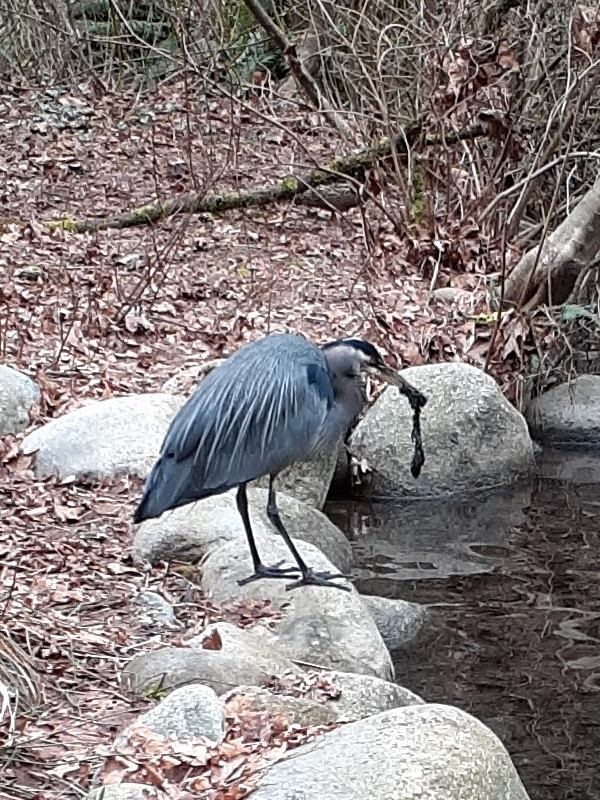
Heron in Vanier Park, Vancouver; Photo by Rescue Volunteer Liz G
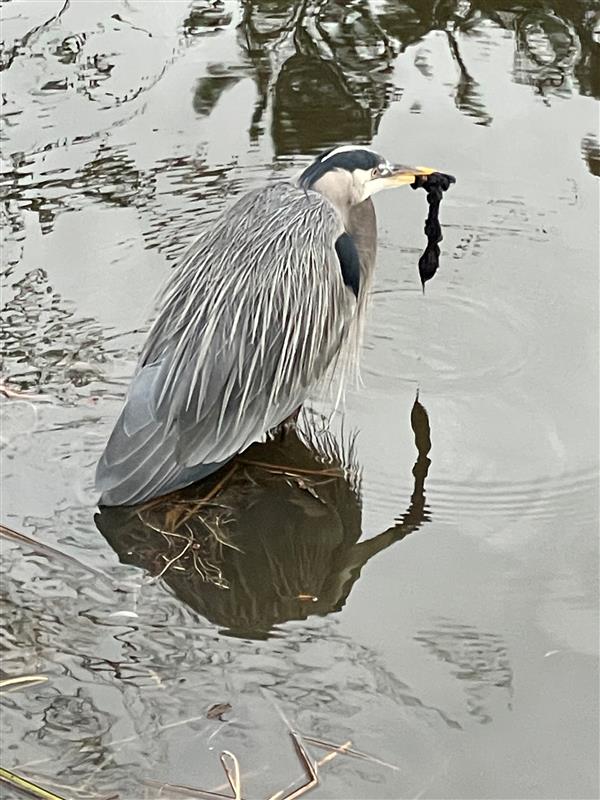
Heron in Murdo Frazer Duck Pond, North Vancouver; Photo by Rescue Volunteer Cathy
Upon intake, the netting was removed and it was revealed that there was no injury to their beak! The heron was in surprisingly good shape, just a little thin as hunting and eating with the entangled netting would have been difficult.
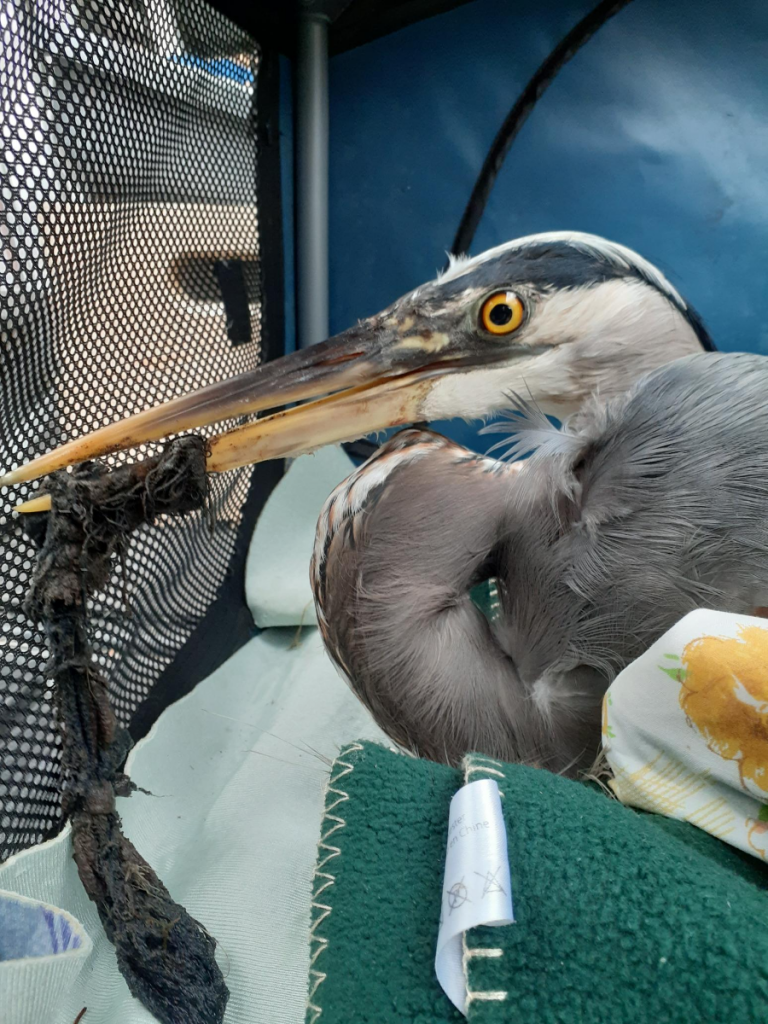
Photo by Rescue Volunteer Liz G.
This Great Blue Heron spent the next week recovering in our “Raptor Pen” – our largest enclosure that allowed them to maintain their flight muscles. This bird ate very well and quickly gained back some much-needed weight!
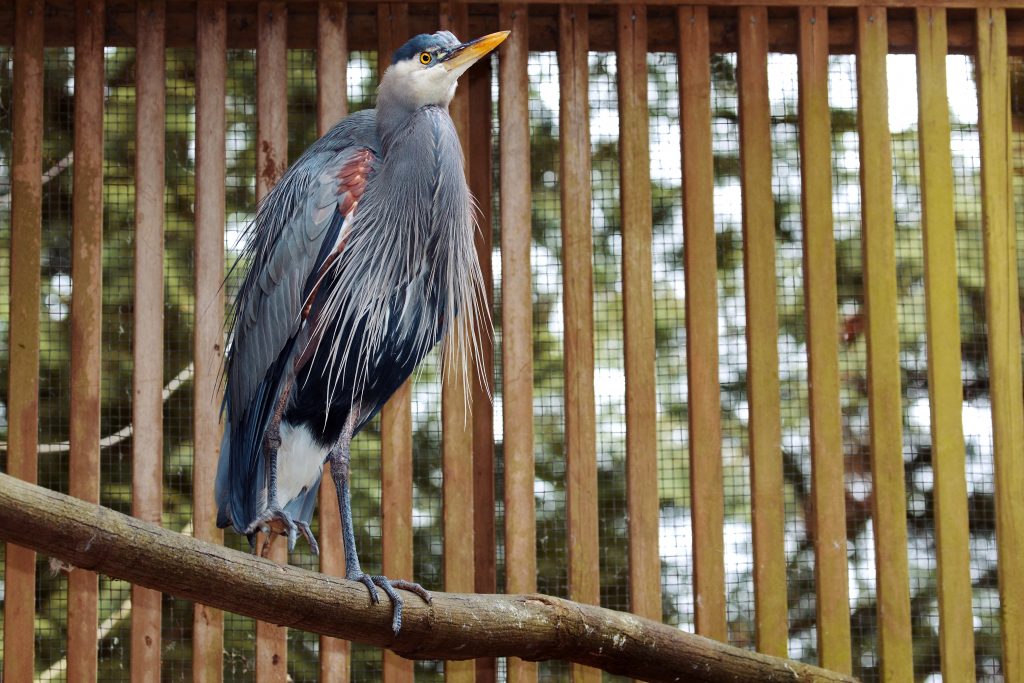
Photo by volunteer photographer Paul S.
After a short stay this heron had a clean bill of health and was released back to nature.
Watch the video of this Great Blue Herons release >
Complicated rescue efforts such as these are only made possible thanks to the generous donations of wildlife lovers like you.
Thanks to the continued support of wildlife lovers like you, this Great Blue Heron gets a second chance at a natural life. Thank you!